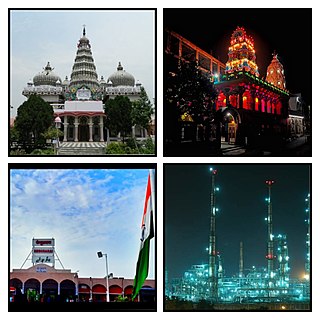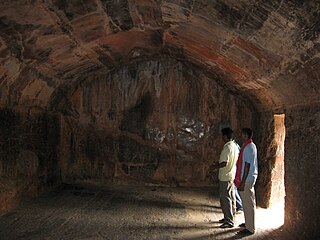
The Ganges is a trans-boundary river of Asia which flows through India and Bangladesh. The 2,525 km-long (1,569 mi) river rises in the western Himalayas in the Indian state of Uttarakhand. It flows south and east through the Gangetic plain of North India, receiving the right-bank tributary, the Yamuna, which also rises in the western Indian Himalayas, and several left-bank tributaries from Nepal that account for the bulk of its flow. In West Bengal state, India, a feeder canal taking off from its right bank diverts 50% of its flow southwards, artificially connecting it to the Hooghly River. The Ganges continues into Bangladesh, its name changing to the Padma. It is then joined by the Jamuna, the lower stream of the Brahmaputra, and eventually the Meghna, forming the major estuary of the Ganges Delta, and emptying into the Bay of Bengal. The Ganges–Brahmaputra–Meghna system is the second-largest river on earth by discharge.

Nalanda was a renowned Buddhist mahavihara in ancient and medieval Magadha, eastern India. Widely considered to be among the greatest centres of learning in the ancient world, and often referred to as "the world's first residential university", it was located near the city of Rajagriha, roughly 90 kilometres (56 mi) southeast of Pataliputra. Operating for almost a thousand years from 427 CE until around 1400 CE, Nalanda played a vital role in promoting the patronage of arts and academics during the 5th and 6th century CE, a period that has since been described as the "Golden Age of India" by scholars.

Bihar is a state in Eastern India. It is the third largest state by population, the 12th largest by area, and the 15th largest by GDP in 2021. Bihar borders Uttar Pradesh to its west, Nepal to the north, the northern part of West Bengal to the east, and Jharkhand to the south. Bihar is split by the river Ganges, which flows from west to east. On 15 November 2000, southern Bihar was ceded to form the new state of Jharkhand. Only 11.27% of the population of Bihar lives in urban areas as per a 2020 report. Additionally, almost 58% of Biharis are below the age of 25, giving Bihar the highest proportion of young people of any Indian state. The official language is Hindi, which shares official status alongside that of Urdu. The main native languages are Maithili, Magahi and Bhojpuri. But there are several other languages being spoken at smaller levels.

The Freer Gallery of Art is an art museum of the Smithsonian Institution in Washington, D.C. focusing on Asian art. The Freer and the Arthur M. Sackler Gallery together form the National Museum of Asian Art in the United States. The Freer and Sackler galleries house the largest Asian art research library in the country and contain art from East Asia, South Asia, Southeast Asia, the Islamic world, the ancient Near East, and ancient Egypt, as well as a significant collection of American art.

Begusarai is the industrial and financial capital of Bihar and the administrative headquarters of the Begusarai district, which is one of the 38 districts of the Indian state of Bihar. The district lies on the northern bank of the river Ganges in the Mithila region of India.

Vikramashila was a Buddhist monastery situated in what is now modern-day Bihar in India. It was founded by King Dharmapala between the late eighth and early ninth century.

Bhagalpur district is one of the thirty-eight districts of Bihar state, India. Bhagalpur is the oldest district of Bihar. Bhagalpur city is the administrative headquarters of this district.

Patna Museum is the state museum of the Indian state of Bihar. Founded on 3 April 1917 during the British Raj to house the historical artefacts found in the vicinity of Patna, it is constructed in the style of Mughal and Rajput architecture, and is known locally as the Jadu Ghar. Artefacts from the ancient India era to 1764 have now been transferred to Bihar Museum.

The National Museum in New Delhi, also known as the National Museum of India, is one of the largest museums in India. Established in 1949, it holds a variety of articles ranging from the pre-historic era to modern works of art. It functions under the Ministry of Culture, Government of India. The museum is situated on Janpath. The blueprint of the National Museum had been prepared by the Gwyer Committee set up by the Government of India in 1946. The museum has around 200,000 works of art, mostly Indian, but some of foreign origin, covering over 5,000 years.

The National Museum of Damascus is a museum in the heart of Damascus, Syria. As the country's national museum as well as its largest, this museum covers the entire range of Syrian history over a span of over 11 millennia. It displays various important artifacts, relics and major finds most notably from Mari, Ebla and Ugarit, three of Syria's most important ancient archaeological sites. Established in 1919, during King Faisal's Arab Kingdom of Syria, the museum is the oldest cultural heritage institution in Syria.

Bhagalpur, historically known as Champa Nagri, is a city in the Indian state of Bihar, situated on the southern bank of the Ganges river. It is the third largest city of Bihar by population and also serves the headquarters of Bhagalpur district, Bhagalpur division, and Eastern Range. It is known as the Silk City and also listed for development under the Smart Cities Mission by Government of India. It is the only district in Bihar after capital city Patna where three major higher educational institutions IIIT Bhagalpur, Jawaharlal Nehru Medical College, TMBU, and Agriculture University (BAU) are located and also Vikramshila Central University is under construction next to the ruins of the medieval Vikramshila Mahavihara. Bhagalpur Railway Station serves the city. The river around city is home to the Gangetic dolphin, the National Aquatic Animal of India, and the Vikramshila Gangetic Dolphin Sanctuary is established near the town. The city holds the largest Manasa Puja and one of the largest processions in Kali Puja, an intangible cultural heritage of the region.
Bihari culture refers to the culture of the Indian state of Bihar. Bihari culture includes Angika culture, Mithila culture, Bhojpuri Culture and the culture of Magadha.

Jain sculptures or Jain idols are the images depicting Tirthankaras. These images are worshiped by the followers of Jainism. The sculpture can depict any of the twenty-four tirthankaras with images depicting Parshvanatha, Rishabhanatha, or Mahāvīra being more popular. Jain sculptures are an example of Jain art. There is a long history of construction of Jain sculptures. Early examples include Lohanipur Torsos which has been regarded to be from the Maurya period, and images from the Kushan period from Mathura.

Angika is an Eastern Indo-Aryan language spoken in some parts of the Indian states of Bihar and Jharkhand, as well as in parts of Nepal.

Jain art refers to religious works of art associated with Jainism. Even though Jainism has spread only in some parts of India, it has made a significant contribution to Indian art and architecture.
Telhara is a village in Ekangarsarai block of Nalanda district, in Bihar. It is also the site of the Telhara monastery which dates back to the 1st-century CE.
Alampur ASI Museum is a museum located in the historical temple town of Alampur, Mahbubnagar in Telangana. Situated at the Navabrahma Temples it is maintained by Archaeological Survey of India.

The Son Bhandar Caves are two man-made caves carved into the base of the Vaibhar Hills in Rajgir in the state of Bihar in India. Based on the dedicatory inscription found in the largest cave — which uses Gupta script of the 4th century CE — the caves are generally dated to the 3rd or 4th century CE, although some authors have suggested the caves could actually go back to the period of the Maurya Empire, possibly as early as 319 BCE. The main cave is rectangular with a trapezoidal entrance and a vaulted ceiling, reminiscent of the structure of the earlier Barabar Caves. The quality of the polish and the finish are nevertheless much inferior to that of the Barabar Caves. The stone of Son Bhandar is also much less hard than the granite of the Barabar caves, and therefore did not require the same degree of effort and technique.
Bihar is a state in eastern India divided by the Ganges river, an area which was once an important center for culture and learning. A Neolithic settlement has been discovered at Chirand which contains rock paintings similar to those found in Spain's Altamira and France's Lascaux regions. The tradition of painting has been handed down from generation to generation in the families of the Mithila and Bhojpur regions mainly by women. Painting was usually done on walls during festivals, religious events, and other milestones of the life cycle, like birth, Upanayanam, and marriage. Other styles of this region include Tikuli, Manjusha, and Patna kalam.

Begusarai Museum or Begusarai Sangrahlaya is a museum in Begusarai district of Indian state of Bihar. The museum consists of artifacts from Buddhist, Maurya and Mughal period. It is open on all days except Monday.















